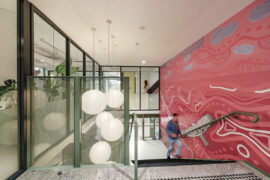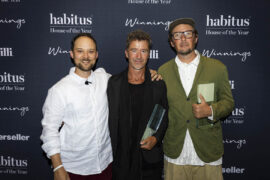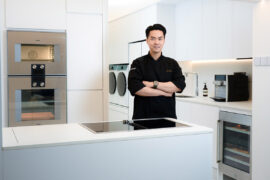Scott Adams, TCL Director, comments on the power of good urban design and landscape architecture.

Scarborough Foreshore (TCL & UDLA), photography by Douglas Mark Black.
May 10th, 2024
As urban designers and landscape architects, ours are the disciplines with the most power to transform public spaces into destinations and drawcards that unite communities and help cities prosper. On any project, when compared to the cost of tunnelling and road construction, landscape architecture is one of the smallest costs but it creates the biggest legacy.
Think of those feelings evoked by walking across a well-designed pedestrian bridge or through parklands or wetlands. Truly transformative projects – those that completely turn the dial on nondescript, neglected or even derelict sites – begin by creating strong connections with landscapes.

A case in point is our design to revamp what was once an unloved beachside strip in Western Australia. Known as the Scarborough Foreshore, the location was dominated by a carpark and largely frequented by local skaters. Now, that location is a ‘must-see’ destination for beach-lovers, shoppers and foodies who visit or live in Scarborough.
We worked as principal consultants, collaborating with local landscape architects from UDLA, to design the masterplan and landscape architecture for the foreshore’s redevelopment. At the time of its inception, this project was an initiative of the Metropolitan Redevelopment Authority and the City of Stirling.

Hon. John Carey, WA’s Minister for Planning, Lands, Housing and Homelessness, described the project as a “major success story, with thousands of locals and visitors descending on Scarborough to enjoy the world-class beach and thriving activity, entertainment precinct.”
Key to our design was reconfiguring the carpark to prioritise pedestrians and give them better access to the beach and the nearby esplanade’s shopping and dining strip. This was achieved via the introduction of two well-shaded, wide promenades. Situated between them are an open-air swimming pool, surf club, restaurant, playground and vertical skate course.

The new design celebrates the region’s surf and skate culture. But it goes a step further, equipping the site with amenities and ample spectator sites to host international skate and surf festivals of the future. We understand that surf culture and skate culture go hand-in-hand. Now, the site could comfortably host international competitions for surfing, surf lifesaving or skating events.
In addition to being ‘future-focussed’, our design strategy also provided a boost to the local economy during the construction phase. We worked closely with local Whadjuk Nyoongar artist Sharyn Egan and architect Fred Chaney from TRCB, as well as local sailmakers. Together, they drew inspiration from the stitching used in Sharyn’s basket weaving to create large sail-like shade structures robust enough to withstand Scarborough’s coastal conditions.

It’s not the first time our designers have drawn upon First Nations’ artistry and insights. We did likewise for our internationally awarded contribution to Victoria’s North East Link project, which rounds out Melbourne’s entire freeway system. Responsible for the project’s urban design and landscape architecture, TCL worked in close collaboration with BKK Architects, Warren and Mahoney Architects and Jefa Greenaway.
Here, we embedded the Wurundjeri philosophy of Connection to Country, Caring for Country and Connecting People. Our design choices were heavily influenced by this notion of a reciprocal relationship with the land.

A good example is the large ventilation tower located at the southern-end of the North East Link (used to extract gas from inside the tunnel). Typically, a tower like this would be clad in a fairly nondescript architectural finish. Instead, our design team incorporated solar panelling. Essentially, we’re generating power that’s immediately fed back into the tunnel’s own lighting grid — this is the most efficient way to create sustainable energy.
Related: TCL’s Deb Robbins comments on Brisbane


Part of the project also involves the design for a series of pedestrian bridges. Beyond being structurally efficient, I believe these bridges should also provide Connection to Country. Each bridge’s design should be specific to its context. Priorities will include the retention and/or reinstatement of original plant communities and ecology.
That contextual connection is also evident in another of our Victorian projects. TCL was recently engaged by the City of Melbourne to lead the development and delivery of the masterplan for Southbank Boulevard. Comprising a series of new public spaces alongside the sites of some of Melbourne’s best known cultural institutions including the Melbourne Recital Centre, the Melbourne Theatre Company and the Victorian College of the Arts, our remit included overseeing the functional and technical issues associated with relocating tram routes, as well as designing distinct identities for each new public space in front of these public institutes.

Each new park space has been designed to create a distinct experience as you move along the boulevard. Here, materiality was key. Bluestone, beloved and abundant in Victoria, is a predominant feature along the footpaths. However, each new pocket of land features alternative stones, and treatments, to give those park spaces their own identities. Planting too has been varied to add character and bolster biodiversity.

Notably, this part of Melbourne is one of the most densely populated parts of Australia. Per square metre, the people living and working here had access to the least amount of public space. Our design gives those people a large area of high-quality public space to enjoy.
In short, the design process always unlocks opportunities and those opportunities lead to better outcomes for people from all walks of life.
TCL
tcl.net.au
Photography
Various
INDESIGN is on instagram
Follow @indesignlive
A searchable and comprehensive guide for specifying leading products and their suppliers
Keep up to date with the latest and greatest from our industry BFF's!

In an industry where design intent is often diluted by value management and procurement pressures, Klaro Industrial Design positions manufacturing as a creative ally – allowing commercial interior designers to deliver unique pieces aligned to the project’s original vision.

Merging two hotel identities in one landmark development, Hotel Indigo and Holiday Inn Little Collins capture the spirit of Melbourne through Buchan’s narrative-driven design – elevated by GROHE’s signature craftsmanship.

From radical material reuse to office-to-school transformations, these five projects show how circular thinking is reshaping architecture, interiors and community spaces.

Milliken’s ‘Reconciliation Through Design’ initiative is amplifying the voices of Aboriginal and Torres Strait Islander artists, showcasing how cultural collaboration can reshape the design narrative in commercial interiors.

Designed by Woods Bagot, the new fit-out of a major resources company transforms 40,000-square-metres across 19 levels into interconnected villages that celebrate Western Australia’s diverse terrain.

In an industry where design intent is often diluted by value management and procurement pressures, Klaro Industrial Design positions manufacturing as a creative ally – allowing commercial interior designers to deliver unique pieces aligned to the project’s original vision.
The internet never sleeps! Here's the stuff you might have missed

Winners of the 2025 Habitus House of the Year and Editor’s Choice Award respectively, Anthony Gill and Jason Gibney join the podcast to discuss the state of housing in Australia today.

Now cooking and entertaining from his minimalist home kitchen designed around Gaggenau’s refined performance, Chef Wu brings professional craft into a calm and well-composed setting.